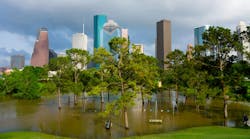Steve Mathies is coastal restoration and resilience global practice leader for Stantec. Mathies can be reached at [email protected]. Robert Esenwein is senior water resources and environmental specialist for Stantec. Esenwein can be reached at [email protected].
undefinedAround the world coastal communities, due to their location, are naturally susceptible to hurricanes and storms. Climate-driven events like hurricanes and tornadoes are increasingly overwhelming coastlines and coastal communities. Now, some communities outside of the floodplain are being affected by these storms.
In the U.S., the two of us have been working on flood risk reduction and coastal restoration since the 1980s. Some of our family members and friends have been deeply impacted by the effects of recent storms. They have lost homes, most of their belongings, and we know others that lost loved ones.
Imagine losing everything like that. If your family has lived in the same community for generations, once a storm hits, you may not have a single photograph from your childhood or a sentimental object to pass down to younger relatives. A storm can take that from you.
Here is something that everyone who lives in a coastal area — or even near one — should know: If you have not lived through one of these storms, it is only a matter of time until you do. The wind and the flooding will come. You need to understand the importance of taking action now to be able to endure the impacts of those storms.
From Prevention to Reduction
There are several reasons for coastal flooding, and here are two major ones. First, areas can receive intense rainfall due to tropical events that create significant amounts of flooding. No matter where you are, if you get 40 inches of rainfall in a three-day period, you are going to have water issues. Second, when storms come ashore, the strong winds push water, known as storm surge, up onto the shoreline. That storm surge has the potential to cause flooding.
Engineers are moving away from the term “flooding control.” Instead, we acknowledge that communities cannot be totally protected for all potential flood events, and we focus today on flood risk reduction. Today it is about managing water. For instance, today we might convert a golf course to a flood retention area instead of building a higher levee with bigger pump stations.
Mid-Breton Sediment Diversion
We are currently working with the state of Louisiana to design a project that could lessen the impacts of coastal storms. The Mid-Breton Sediment Diversion project will reconnect the Mississippi River to adjacent coastal marshes that were historically built and nourished by annual river flows to help reverse the effects of land loss along the Louisiana coast.
The sediment-rich flows from the Mississippi River during annual river flooding events built coastal Louisiana. However, the construction of flood control levees along the lower Mississippi River has prevented those needed flows from reaching wetlands to sustain Louisiana’s coastal landscape. The purpose of this project is to reconnect the river to deteriorating deltaic wetlands in the Breton Sound Basin and, in so doing, provide some storm surge benefits to populated areas south of New Orleans.
This project provides us with examples of communities that have been so battered by intense storms, storm surges and flood risks that they must do something different and dramatic if those communities are to survive. Reconnecting the Mississippi River to the coastal landscape is one of the tools available.
The Importance of Wetlands
While there are many reasons to restore wetlands, our focus is on storm surge reduction. Storm surge builds over open water, and open water is needed to maintain that energy. Wetlands dissipate that energy, lowering storm surge in the process and helping protect coastal communities and assets.
In southeast Louisiana, all the coastal wetlands are subsiding. They are no longer being nourished by sediment-rich flows of the Mississippi River. By rebuilding the coastal landscape — by reconnecting the Mississippi River to the wetlands — we can help to protect and sustain coastal communities and mitigate flood risk.






